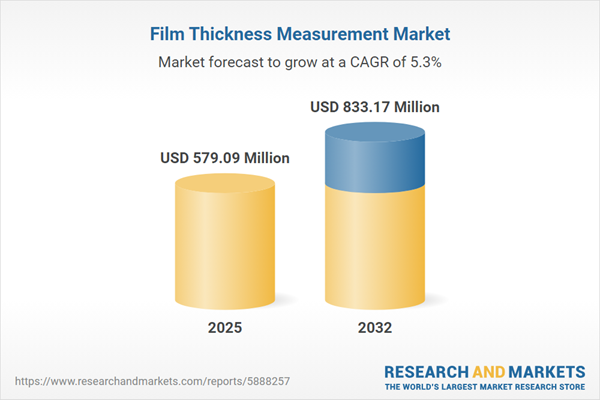Speak directly to the analyst to clarify any post sales queries you may have.
The film thickness measurement market plays a pivotal role in supporting senior decision-makers as they navigate the complexities of digitalized manufacturing, strict compliance standards, and evolving industrial requirements. Reliable measurement solutions are now a foundation for maintaining product integrity and optimizing processes in automated and regulated production ecosystems.
Market Snapshot: Film Thickness Measurement Market Overview
The global film thickness measurement market is experiencing sustained expansion, valued at USD 549.99 million in 2024, and forecast to reach USD 833.17 million by 2032 with a CAGR of 5.32%. Growth is reinforced by increasing regulatory expectations and widespread digital manufacturing adoption. Automated measurement tools are gaining traction in sectors such as automotive, medical devices, and semiconductors. The integration of real-time analytics and automation within manufacturing workflows is leading to better product yields, greater process consistency, and more agile responses to regulatory shifts on a global scale.
Scope & Segmentation
- Technology: The market supports a diverse array of measurement technologies, including eddy current, RF eddy current, magnetic induction, magnetoelastic, confocal profiling, spectral reflectance, white light interferometry, ultrasonic attenuation, ultrasonic time of flight, and X-ray systems. These options enable manufacturers to address varied metrology demands while aligning with automation strategies.
- End User: Focused on industries such as aerospace, automotive, medical devices, semiconductor manufacturing, and consumer electronics, film thickness measurement addresses critical process control needs and quality objectives specific to each sector.
- Material: Equipment compatibility spans metals, glass, polymers, and semiconductors, ensuring reliable measurement regardless of substrate and supporting innovation in coatings and thin films.
- Thickness Range: Solutions encompass measurements for ultra-thin films below 50 microns to coatings exceeding 1000 microns, serving both R&D environments and high-volume industrial applications.
- Instrument Type: The market accommodates both contact and non-contact instruments, which can be integrated into existing production lines or leveraged in the modernization of legacy systems.
- Sales Channel: Offerings are available via direct sales, authorized distributors, and online platforms, adapting to the procurement preferences of multinational organizations and regional enterprises.
- Regions: Innovation is prominent in the Americas and Europe, where regulatory demands drive adoption of sophisticated solutions. Asia-Pacific and Middle East & Africa present opportunities with scalable, cost-focused systems tailored to burgeoning industrial growth.
Key Takeaways for Senior Decision-Makers
- Advanced measurement platforms underpin process consistency and compliance, directly contributing to a company's competitiveness and operational robustness.
- Sensor-driven and modular systems simplify production changes, minimizing downtime when manufacturers adopt new materials or pivot production priorities.
- Regional priorities reflect distinct dynamics: North American leaders often focus on manufacturing digitization, while Asia-Pacific organizations prioritize modular, flexible solutions to support rapid diversification and expansion.
- AI-powered analytics and tools for spectral reflectance enhance early detection of variances in the production process, facilitating predictive maintenance and safeguarding production reliability.
- Strategic supplier partnerships enable tailored monitoring, helping streamline efforts in regulatory compliance and reduce disruptions linked to shifting market and regulatory pressures.
Tariff Impact and Supply Chain Considerations
Recent U.S. tariff changes affecting precision measurement equipment are prompting companies to reevaluate procurement models and supplier relationships. These shifts may introduce longer lead times but can also deliver long-term benefits, such as improved integration of digital metrology, a focus on internal calibration capabilities, and enhanced supply chain resilience. This climate encourages proactive sourcing strategies, fosters greater adaptability, and supports broader risk mitigation efforts.
Methodology & Data Sources
Findings are grounded in primary interviews with engineers, quality assurance leaders, and precision instrument manufacturers. The insights are further substantiated by independent industry surveys, literature reviews, benchmarking exercises, and patent analysis to ensure the reliability and integrity of this market research.
Why This Report Matters for Industry Leaders
- Delivers benchmarks critical for senior management evaluating new film thickness measurement investments and guiding capital allocation for compliance and operational excellence.
- Equips procurement and operations executives with informed strategies to address evolving tariff environments, regulatory demands, and supply chain vulnerabilities.
- Offers actionable guidance for optimizing supplier partnerships and implementing cutting-edge metrology, supporting agility and responsiveness in volatile market conditions.
Conclusion
This report provides senior executives with practical insights to enhance compliance, accelerate digital transformation, and ensure consistent, efficient manufacturing operations as the film thickness measurement landscape continues to evolve.
Additional Product Information:
- Purchase of this report includes 1 year online access with quarterly updates.
- This report can be updated on request. Please contact our Customer Experience team using the Ask a Question widget on our website.
Table of Contents
3. Executive Summary
4. Market Overview
7. Cumulative Impact of Artificial Intelligence 2025
Companies Mentioned
The companies profiled in this Film Thickness Measurement market report include:- KLA Corporation
- Thermo Fisher Scientific Inc.
- Bruker Corporation
- Agilent Technologies, Inc.
- Keyence Corporation
- Onto Innovation Inc.
- AMETEK, Inc.
- Spectris plc
- Shimadzu Corporation
- Hitachi High-Tech Corporation
Table Information
| Report Attribute | Details |
|---|---|
| No. of Pages | 181 |
| Published | October 2025 |
| Forecast Period | 2025 - 2032 |
| Estimated Market Value ( USD | $ 579.09 Million |
| Forecasted Market Value ( USD | $ 833.17 Million |
| Compound Annual Growth Rate | 5.3% |
| Regions Covered | Global |
| No. of Companies Mentioned | 11 |









